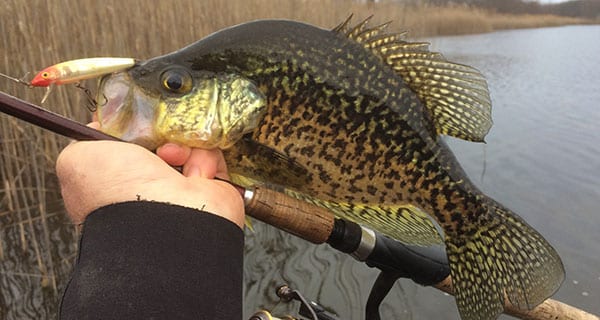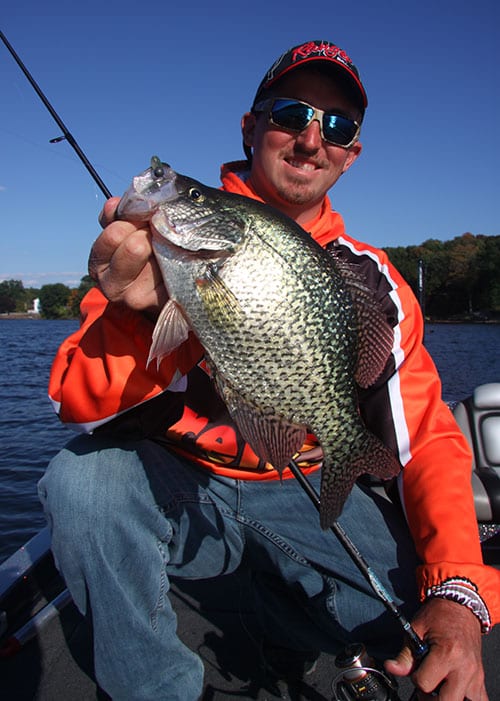
By Tom Schlichter
The early spring waters were crystal clear and as I waded along the muddy shoreline I could see deep into the weed edges where bigmouths like to patrol. Passing by these traditional bass hot spots without casting, I continued on toward my goal – the mouth of a shallow cove where a dead and branchy tree dipped into three feet of water. I had crappies on the brain this morning. The bass would have to wait for another day.
It took only two casts to know my efforts were worthwhile as a fat, slab-sided paper mouth pushed up a heavy wake and inhaled a small white spinnerbait. Three more casts produced two more crappies and I realized I was in fishing heaven. Over the next hour several more of the yellow-sided panfish would smack my lures. Two of them would top the 12-inch mark, a third pushed past 14 inches. Those are jumbo sizes anywhere – but especially here in the Northeast.
SPRING DELIGHT
Whether you live in Connecticut, Rhode Island or New York, crappies are spring delight. Willing, aggressive and capable of putting up a decent battle on four- to six-pound class spinning gear, they provide an entertaining change of pace from the never-ending pursuit of bass and trout. That’s not to say I don’t take crappies seriously, just that I really make the effort to enjoy them during the spring, which generally happens to be their peak season.

Calico bass, strawberry bass and specks, as black crappies are also called, generally aren’t the most abundant of fish in Northeast waters, so you may need to put in a time and effort to track them down. Going back only a couple of decades, they relatively sparse in the waters of Connecticut, Rhode Island and, especially Long Island. As a rule they inhabited bigger waters but these days there seem to be quite a few smaller lakes and ponds with substantial populations. I’m guessing you can chalk up their expanding abundance in part to a few “Johnny Crappieseeds” making illegal transfers over the years. While I’m all for catching crappies where they already thrive, it is important to note that “seeding” with these prolific panfish can have devastating effects on existing fish populations. In other words, don’t take spreading crappies into your own hands.
LURE CHOICES
Since crappies are fairly aggressive during the spring, you can catch them on a wide variety of lures. Early in the season, when the water is still cold, many anglers opt for a simple jig and float approach. This setup calls for suspending a one-inch curly-tailed grub 20 inches to 3 feet below a float. Tip the jig with a single wax worm or Berkley Gulp! Waxie, cast out and allow it to set for a minute or two. If you don’t get a bite right away reel in slowly, six inches at a time, and let it sit again. Most strikes happen while the jig and float are standing still.
Crappies also strike many of the same plugs and spinners that anglers use to target largemouth bass. Because the panfish have smaller mouths and smaller bodies, however, you’ll want to scale down the size of the lures offered. Instead of a big spinnerbait, for example, try tempting them with a small Beetle Spin in chartreuse, black or white, or throw a 2-1/2-inch floating Rapala minnow. Silver in-line spinners, size 1 are another good bet. Both the spinners and spinnerbaits work especially well when buzzed just below the surface as the water warms up from late April through late May. At this point, crappies are at their most aggressive and they’ll actually race to the wake of these lures in order to intercept a perceived meal.
Yet another way to hook into some chunky slabs is to target them with fly-fishing gear. Big nymphs are my favorite choice for this with a black bead-head Wooly Bugger accounting for several crappies I’ve caught over the years that broke the 14-inch mark. Usually, I’ll slow-strip these flies in 2- to 4-inch increments, setting the hook if I see a line twitch or feel extra weight by holding the line tight and steadily raising the rod tip. This technique works best while the water is still cold and the weeds still have a foot or two to grow before reaching the surface.

BRUSH AND FLATS
You’ll find crappies like to hang on the edges of flats and along cove mouths, basking in the sun and enjoying the growing warmth of the shallows during April, May and early June. By late June, however, they’ll tend to push back into thick, overhanging brush or suspend amongst the branches of submerged timber and bushes. That means you’ll need to change your perspective as the season advances.
Either way, you’ll find crappies are most aggressive at first light and just before the sun goes down. If you can force yourself to fish through the aggressive evening clouds of mosquitoes and no-see-ums in late spring and early summer, you’ll likely rack up your best scores of the season.
Keep in mind that these scrappy panfish can be somewhat fragile if handled with a heavy hand. They are not nearly as tough as bluegill or pumpkinseed in general, and the bigger the crappie the faster it seems to fade. For this reason, it’s a good idea to crimp down the barbs on your lures if you plan to play catch and release. Keeping a forceps within easy reach as you might when trout fishing is also a good idea as it makes unhooking fish that have fully swallowed your offering a simple task.
If released with reasonable speed, most specks will swim off in good condition. If however, a fish you intend to release seems sluggish, take an extra minute or two to revive it by cupping it under the pectoral fins and sliding it back and forth – gently – through the water. It’s amazing how quickly a spent-looking speck will respond to this simple measure. In as little as 30 to 60 seconds, most will wiggle free, fully ready to battle again the next time you are up to the challenge.









